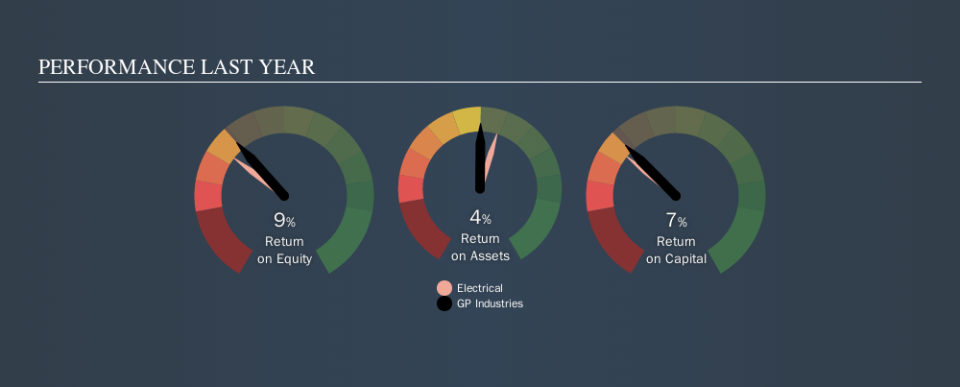Evaluating GP Industries Limited’s (SGX:G20) Investments In Its Business

Today we are going to look at GP Industries Limited (SGX:G20) to see whether it might be an attractive investment prospect. Specifically, we'll consider its Return On Capital Employed (ROCE), since that will give us an insight into how efficiently the business can generate profits from the capital it requires.
First of all, we'll work out how to calculate ROCE. Next, we'll compare it to others in its industry. Then we'll determine how its current liabilities are affecting its ROCE.
Return On Capital Employed (ROCE): What is it?
ROCE measures the amount of pre-tax profits a company can generate from the capital employed in its business. Generally speaking a higher ROCE is better. Ultimately, it is a useful but imperfect metric. Author Edwin Whiting says to be careful when comparing the ROCE of different businesses, since 'No two businesses are exactly alike.
How Do You Calculate Return On Capital Employed?
Analysts use this formula to calculate return on capital employed:
Return on Capital Employed = Earnings Before Interest and Tax (EBIT) ÷ (Total Assets - Current Liabilities)
Or for GP Industries:
0.066 = S$41m ÷ (S$1.3b - S$657m) (Based on the trailing twelve months to June 2019.)
So, GP Industries has an ROCE of 6.6%.
Check out our latest analysis for GP Industries
Is GP Industries's ROCE Good?
ROCE can be useful when making comparisons, such as between similar companies. It appears that GP Industries's ROCE is fairly close to the Electrical industry average of 7.9%. Setting aside the industry comparison for now, GP Industries's ROCE is mediocre in absolute terms, considering the risk of investing in stocks versus the safety of a bank account. Readers may find more attractive investment prospects elsewhere.
You can see in the image below how GP Industries's ROCE compares to its industry. Click to see more on past growth.
When considering this metric, keep in mind that it is backwards looking, and not necessarily predictive. Companies in cyclical industries can be difficult to understand using ROCE, as returns typically look high during boom times, and low during busts. ROCE is only a point-in-time measure. If GP Industries is cyclical, it could make sense to check out this free graph of past earnings, revenue and cash flow.
How GP Industries's Current Liabilities Impact Its ROCE
Short term (or current) liabilities, are things like supplier invoices, overdrafts, or tax bills that need to be paid within 12 months. Due to the way ROCE is calculated, a high level of current liabilities makes a company look as though it has less capital employed, and thus can (sometimes unfairly) boost the ROCE. To counteract this, we check if a company has high current liabilities, relative to its total assets.
GP Industries has total assets of S$1.3b and current liabilities of S$657m. As a result, its current liabilities are equal to approximately 51% of its total assets. With a high level of current liabilities, GP Industries will experience a boost to its ROCE.
What We Can Learn From GP Industries's ROCE
Despite this, the company also has a uninspiring ROCE, which is not an ideal combination in this analysis. But note: make sure you look for a great company, not just the first idea you come across. So take a peek at this free list of interesting companies with strong recent earnings growth (and a P/E ratio below 20).
I will like GP Industries better if I see some big insider buys. While we wait, check out this free list of growing companies with considerable, recent, insider buying.
We aim to bring you long-term focused research analysis driven by fundamental data. Note that our analysis may not factor in the latest price-sensitive company announcements or qualitative material.
If you spot an error that warrants correction, please contact the editor at editorial-team@simplywallst.com. This article by Simply Wall St is general in nature. It does not constitute a recommendation to buy or sell any stock, and does not take account of your objectives, or your financial situation. Simply Wall St has no position in the stocks mentioned. Thank you for reading.

